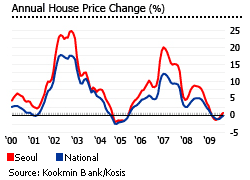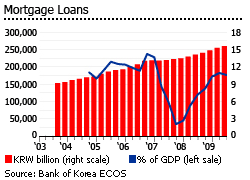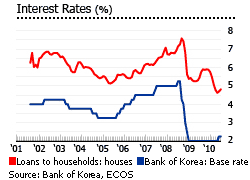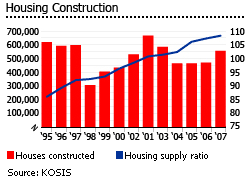The tables have turned in South Korea

The downturn that many experts have been talking about has begun, and South Korean house prices started to fall in the beginning of Q3 2010.
According to the Korean Statistical Information Service, nationwide house prices declined 0.13% (-0.30% inflation-adjusted) over the three months to August 2010, following an earlier decline of 0.04% (-0.65% inflation-adjusted) in July 2010.
On a year-on-year basis, house prices rose 2.29% in August 2009. However, when adjusted for inflation, prices actually dropped 0.26% over the same period.
Housing transactions have been dismal since the beginning of 2010. In June, home sales transactions were down to 65,197 units, 20% lower than in June last year. Seoul and other metropolitan areas suffered harder, with house sales down 55% over the year to June 2010.
Back in 2009, many believed that a property bubble was forming in South Korea. The government was quick to react by implementing anti-speculation policies.
The tables have turned in 2010, prompting the government to reverse its policies. The debt-to-income cap was temporarily suspended starting July 2010. Capital gain tax relief was extended for two more years. Furthermore, the government plans to implement stimulus measures to support cash-strapped builders.
Back when house prices were rising

The Seoul house price index inched up in 2009, rising 3.6% (2.8% in real terms) from April to October 2009. Nationally, the house price index rose 2.1% (1.3% in real terms) over the same period, according to data from Koomin Bank.
However the government moved swiftly to tighten loan conditions, to forestall a perceived housing bubble. In July, it reduced loan-to-value ratios from 60% to 50% for the purchase of properties in Seoul and other urban areas. It also instructed banks to scrutinize borrowers’ income when granting loans.
Real estate transactions have now turned sluggish. Apartment transactions in Seoul were down 16.6% from the previous month in October, but in Seoul’s luxurious southern districts such as Gangnam, Seocho and Songpa, transactions totaled a mere 893, half that of the previous month ― the lowest level this year.
In Korea, every time residential property prices rise sharply, the government intervenes. For instance in 2006, when the index rose 18.9% (16.4% in real terms) in Seoul, capital gains taxes fore properties in “speculative areas” were hiked.
House price rises slowed in 2007 to 5.4% in Seoul (1.75% in real terms) and 3.1% nationally (0.6% in real terms). In 2008, house price rises were a mere 5% for Seoul (0.86% after inflation) and 3.1% nationally (-1.5% after inflation).
The quick recovery of house prices in 2009 may be attributed to:
- government spending and tax breaks to households;
- increased financial system liquidity; and
- optimism that the economy is set to improve.
Korea’s economic record is good
Korea’s economy succumbed to recession during the first half of 2009. The economy has bounced back beginning Q3 2009, expanding by 1% from a year earlier. Strong year-on-year rises were recorded since then- 6% in Q4 2009, 8.10% in Q1 2010 and 7.20% in Q2 2010. The economy is expected to grow by 6.1% by the end of 2010.
The government played a big role in Korea’s quick economic recovery. The government has reduced taxes, as well as interest rates. In January 2009, the government announced KRW50 trillion (US$38 billion) investments over four years for major infrastructure and environmental projects to create 960,000 jobs. In February 2009 came a US$37 billion credit guarantee to firms, and tax cuts for homeowners.
To stabilize the foreign exchange markets, the Bank of Korea supplied financial institutions with US$22.4 billion in Q1 2009 through swap transactions and foreign currency loans, using the proceeds of currency swaps with the US Federal Reserve. The government also injected US$30 billion worth of liquidity into the banking system.
With the renewed strength of the economy, the government is expected to gradually withdraw its supportive policies. The process has begun in July 2010, when the Bank of Korea raised the key interest rate from a record-low of 2% to 2.25%.
Mortgage lending is strong

Mortgage loans resumed their double-digit growth in 2009, growing by 10.6% y-o-y in the first three quarters, significantly up on 5% growth during the same period in 2008. From 2003 to 2008, the outstanding mortgage-to-GDP ratio rose from 19.9% to 23.9%. Loans have risen much faster than the deposit base, so the average loan-to-deposit ratio stands at 130. Banks finance their deficit by overseas borrowings.
Tax breaks are helping owners
In 2008, the government rationalized the capital gains tax, lowering the tax burden on mid-income households. In case of households owning only one house:
- deductions have been expanded to 10 years;
- the price level eligible for capital gains tax exemption has been raised to KRW 900 million (US$781,000) from KRW 600 million (US$521,000);
- tax burden has been reduced by 3 percentage points, and now ranges from 6% to 33%, down from 9% to 36% (in line with the income tax rate);
- the residence requirement has been tightened, so that the capital gains tax benefit can only be enjoyed by owner-occupiers
In September 2008, to boost construction, the government adjusted the Comprehensive Real Estate Holding Tax (CRHT) for houses, raising the tax base from KRW600 million (US$521,000) to KRW900 million (US$781,900). CRHT rates were lowered to 0.5% - 1%, from 1% - 3%. Senior citizens (aged 60 or more) will get an additional 10% to 30% tax cut, if they own only one house.
Low interest rates propel recovery

The housing market’s quick recovery was propelled by low interest rates. Around 80% to 95% of new housing loans approved in South Korea are on floating interest rates, making the mortgage market sensitive to interest rate changes. Base rates fell from 5.25% in September 2008 to a historic low of 2.0% in February 2009, where they remained for the rest of the year.
When global interest rates started rising 2007 due to inflationary pressures, South Korea also adjusted its key rates upwards. Interest rates on housing loans rose to 7.08% in January 2008, declined slightly then inched up to 7.42% in November 2008. But they then fell to around 5.25% in Q2 2009, gradually rising again to 5.90% in December 2009. Interest rates started to fall again in 2010, to 4.81% in August 2010.
President Lee has been a disappointment

South Korea started 2008 on a note of optimism, with President Lee Myung-bak’s inauguration in February. The former Hyundai Construction CEO and mayor of Seoul was expected to bring economic and administrative competence. Lee ran on a platform of “Economy, First!” in sharp contrast to the erratic policies of left-of-centre former president Roh-Moo-hyun.
However President Lee’s first few months were wasted dealing with the unpopular US beef trade agreement, reducing his political capital.
Then the international financial crisis hit. Global demand for Korea’s electronic goods, semiconductors and automobiles slowed, adding to pressure on the Won. The South Korean won (KRW) quickly depreciated from KRW915 per US dollar in October 2008, to KRW1,453 per dollar in March 2009. Investors, alarmed by Korean corporations’ leverage levels, dumped more than US$37 billion worth of stocks in 2008.
Better economic condition has helped the Korean won to appreciate in 2010. By August 2010, the average exchange rate was KRW1,180 per US dollar.
Serious low-end housing oversupply

South Korea has a very long history of interventions in the housing market to deter speculation or lower house prices. Sadly, this intervention has had disastrous results.
To bring down prices, the government, beginning with Kim Dae-Jung (1998-2003) gave tax-breaks for the construction of five million housing units within ten years or around 500,000 units per year, including many low-income rental units. Left-of-center Roh Moo-hyun (2003-2008) felt that average house prices were beyond the reach of average Koreans (in Seoul´s most popular neighborhoods, three-bedroom apartments can now cost $2 million, about 100 times the average national income). He introduced a number of measures to slow price gains, including raising capital gains taxes by as much as 60%, and limiting the size of some bank loans so that monthly payments do not exceed 40% of a borrower´s monthly income.
Yet ironically, South Korea faces an alarming glut of new housing over the next 5 years. The country´s construction industry is grappling with a large number of unsold apartments. Potential homebuyers have taken a wait-and-see attitude since early last year.
It doesn’t help that transaction costs in South Korea are among the highest in Asia and developed countries.
As a result, the country´s construction industry is grappling with a large number of unsold apartments. The ratio of housing units to households has increased from 72.4% in 1990 to 108.1% in 2007, and is expected to reach 116.7% in 2012.
The number of unsold apartments is now the highest in 11 years, with 129,858 unsold apartments in August 2008, according to the Ministry of Land, Transport and Maritime Affairs. An official at the Construction Association of Korea, a lobby group, has warned that the number continues to pile up, more than 200 builders will be out of business by the year´s end.
Unique rental system hits young people
In Korea’s unique chonsei (or jeongsei) rental system, the tenant pays a lump-sum amount of deposit to the owner for the use of the property, with no additional requirement for periodic rent payments. The deposit is fully refunded at the end of contract period with no interest.
The Chonsei system eliminates the likelihood of tenant’s default on monthly rent as the deposit is maximized until the end of the contract period. However, the lump-sum deposit, equivalent to 70% to 80% of the property value, imposes a huge burden for younger renters and new households.
According to Population and Housing Census Report 2000, 54% of households are in owner occupied houses while 28% are under chonsei contracts. The remaining 18% is under a monthly rental system called wolse.